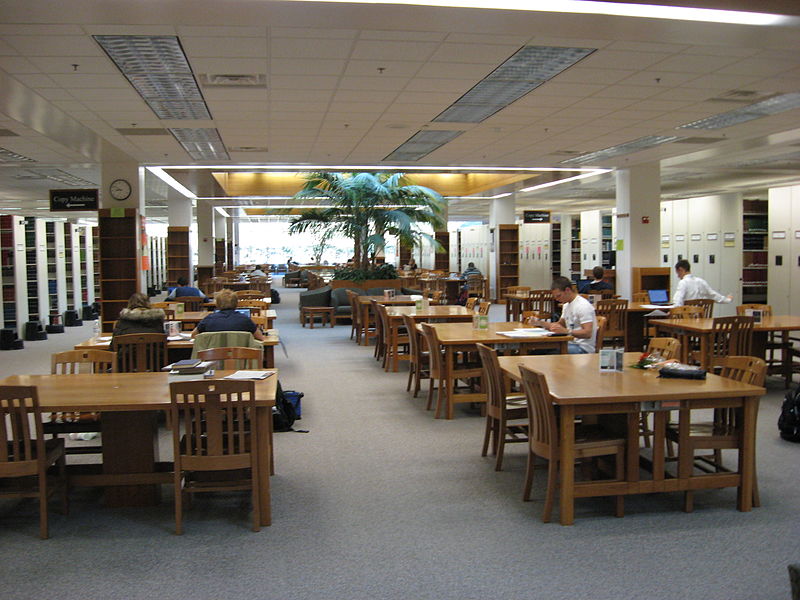
I think it’s important to get your surroundings as well as yourself into a positive state . . . –Heidi Klum, fashion model and television host
LEARNING OBJECTIVES
By the end of this section, you will be able to:
- Analyze the impact of your surroundings while you study
- Define distraction and multitasking
- Assess the degree to which personal technology may help or hinder your study efforts
The Impact of Your Surroundings While You Study
If a researcher walked up to you right now and asked you to identify your favorite place to study, what would your immediate response be? Would it be your home—perhaps your sunny kitchen? Maybe your dorm room or bedroom—a relaxed space you can call your own? Maybe it would be a busy café in the heart of town or a remote log cabin, if you have access to one. What are your preferences for your physical surroundings when you study? What are the attributes of your most conducive study environment?
In the following video, Mark Montgomery, an educational consultant and college admissions expert, reminds students that while their image of college may be much about socializing, they will ideally spend a good portion of their time studying. He shows some accommodating physical spaces at Seattle University.

Student Responses
College administrators, like the one in the video you just watched, may have their own ideas about what constitutes good study space. But what do students say? Below are comments from several students about their favorite “go-to” study spots:
LeeAnne: The main library is my go-to. If I need sources for a paper, the staff help me find articles with their online services. There is a wide selection of books, too, but if I can’t find something the staff will order it through a different school or library. Sometimes the space gets real crowded, like during exam week, and it can be hard to find an open computer. But it’s comforting to see I’m not the only student doing a paper last-minute. The best place for relaxing or writing is the third floor. I like looking out the windows at the scenery.
It’s not surprising to find that there are some recurring student favorites when it comes to good study environments. The following locations are all-time winners:
- A library
- A bookstore
- A park
- A classroom
- A study partner’s house
- A community center
- A tutoring center
Distractions and Multitasking
“Multitasking”—doing several things at the same time—has become a common word for describing what many of us do every day in the modern world. Our busy lifestyles and our ever-present devices suggest that many of us have become multitasking experts.
But is multitasking real? Is it possible to do several things at the same time? Can we actually check Facebook, watch television, read a textbook, and write a paper at roughly the same time . . . productively?
Switch Tasks = Lose Productivity
Evidence suggests that multitasking is not, in fact, possible. Psychology research shows that we can attend to only one cognitive task at a time. [1]What we call multitasking is actually just switching back and forth between tasks quickly. This isn’t necessarily a problem, but we lose time with each switch. The loss may only be one-tenth of a second, but the time adds up. Think about your own experience.
Busy Brains
Researchers have found that multitasking increases production of the stress hormone, cortisol, and the fight-or-flight hormone, adrenaline. [2]These hormone-level increases can cause the brain to literally overheat, which leads to foggy mental processing. So multitasking while studying for a final exam might not be a good idea.
Multitasking also taxes the prefrontal cortex, the part of the brain that integrates information. Your capacity for problem-solving decreases with the number of tasks you try to perform at the same time.
Personal Technology: Helping or Hindering Your Study Efforts
The perceived need to multitask is driven largely by the technology takeover of recent years. Smartphones, email, social networking, Instagram, Twitter . . . all make multitasking seem both necessary and possible. They all require switching in and out of a line of thinking. With these technologies, we face constant information overload and distraction.
Becoming More Productive
How can we become more productive with our time and energy, given our tendency to multitask? Read the tips below:
- Try “batch processing”: Have set times during the day for checking and responding to emails.
- Use concentrated time: Block off time for working on just one task. You may need to turn off your phone.
- Do what’s most important first: Make goals for the day and accomplish them. The sense of achievement can help you resist anxiety-driven multitasking.
What are your thoughts on multitasking? How does it affect your productivity? The following video, from the University of British Columbia, features students talking about multitasking. Does it exist? Is it effective?

- Your Physical Environment. Authored by: Linda Bruce. Provided by: Lumen Learning. License: CC BY: Attribution
- Image of modern workspace. Authored by: Michael Coghlan. Located at: https://flic.kr/p/kgJrSu. License: CC BY-SA: Attribution-ShareAlike
- Students Talk: Multitasking. Authored by: JWang. Provided by: UBC Learning Commons. Located at: http://learningcommons.ubc.ca/students-talk-multitasking/. License: CC BY-SA: Attribution-ShareAlike
- UBC Students Talk: Multitasking – Does It Work?. Authored by: UBC LEAP. Located at: https://youtu.be/QStKeI9Bluc. License: CC BY: Attribution
- Educational Consultant Explains Importance of College Study Spaces. Authored by: GreatCollegeAdvice. Located at: https://youtu.be/hJzAxhnrMGg. License: All Rights Reserved. License Terms: Standard YouTube License
- Image of library. Authored by: Eustress. Located at: https://commons.wikimedia.org/wiki/File:HBLL_periodicals.JPG. License: Public Domain: No Known Copyright
- Image: Vector Video. License: Public Domain: No Known Copyright
